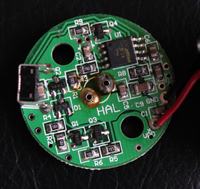grahamt
Newbie level 4

Dear all,
I own a powerful halogen torch which is designed for mountain biking at night. The torch comprises an Li-Ion battery, and a 'light unit' where the halogen bulb is housed, and a cable to connect the two together. My project has been to make a second battery so I'm not just relying on one.
Specifics are:
Original battery is 11~12 volts, 2200mAh.
The halogen bulb is rated at 10W and 6V.
I've made the new battery from two remote-control car batteries. It is made up of nine 1.3V 4700mAh cells connected in series, and in total gives out about 12V as required. I have charged up the 'home-made' battery successfully and connected it to the light unit and it all works!
The problem is that the light unit is getting quite a lot hotter when using my homemade battery compared to the original battery. The only reason I can think of is that the original battery might have a resistor inside the casing to limit the current drawn by the halogen bulb. Could this be true?
What would I need to do to work out the rating of the resistor I need?
Any assistance would be brilliant!
Graham
---------- Post added at 18:09 ---------- Previous post was at 17:28 ----------
Just finished testing the new battery. The home-made battery lasts for approximately 2.3 hours, so a bit less than the original. But the light unit gets too hot to touch, only when using the homemade battery.
Why are the two batteries running for almost the same amount of time and yet one is 2200mAh and the other is 4700mAh? Is this the reason my light is getting so hot? Am I drawing too much current and it's just dissipating as heat?
Thanks!
I own a powerful halogen torch which is designed for mountain biking at night. The torch comprises an Li-Ion battery, and a 'light unit' where the halogen bulb is housed, and a cable to connect the two together. My project has been to make a second battery so I'm not just relying on one.
Specifics are:
Original battery is 11~12 volts, 2200mAh.
The halogen bulb is rated at 10W and 6V.
I've made the new battery from two remote-control car batteries. It is made up of nine 1.3V 4700mAh cells connected in series, and in total gives out about 12V as required. I have charged up the 'home-made' battery successfully and connected it to the light unit and it all works!
The problem is that the light unit is getting quite a lot hotter when using my homemade battery compared to the original battery. The only reason I can think of is that the original battery might have a resistor inside the casing to limit the current drawn by the halogen bulb. Could this be true?
What would I need to do to work out the rating of the resistor I need?
Any assistance would be brilliant!
Graham
---------- Post added at 18:09 ---------- Previous post was at 17:28 ----------
Just finished testing the new battery. The home-made battery lasts for approximately 2.3 hours, so a bit less than the original. But the light unit gets too hot to touch, only when using the homemade battery.
Why are the two batteries running for almost the same amount of time and yet one is 2200mAh and the other is 4700mAh? Is this the reason my light is getting so hot? Am I drawing too much current and it's just dissipating as heat?
Thanks!



